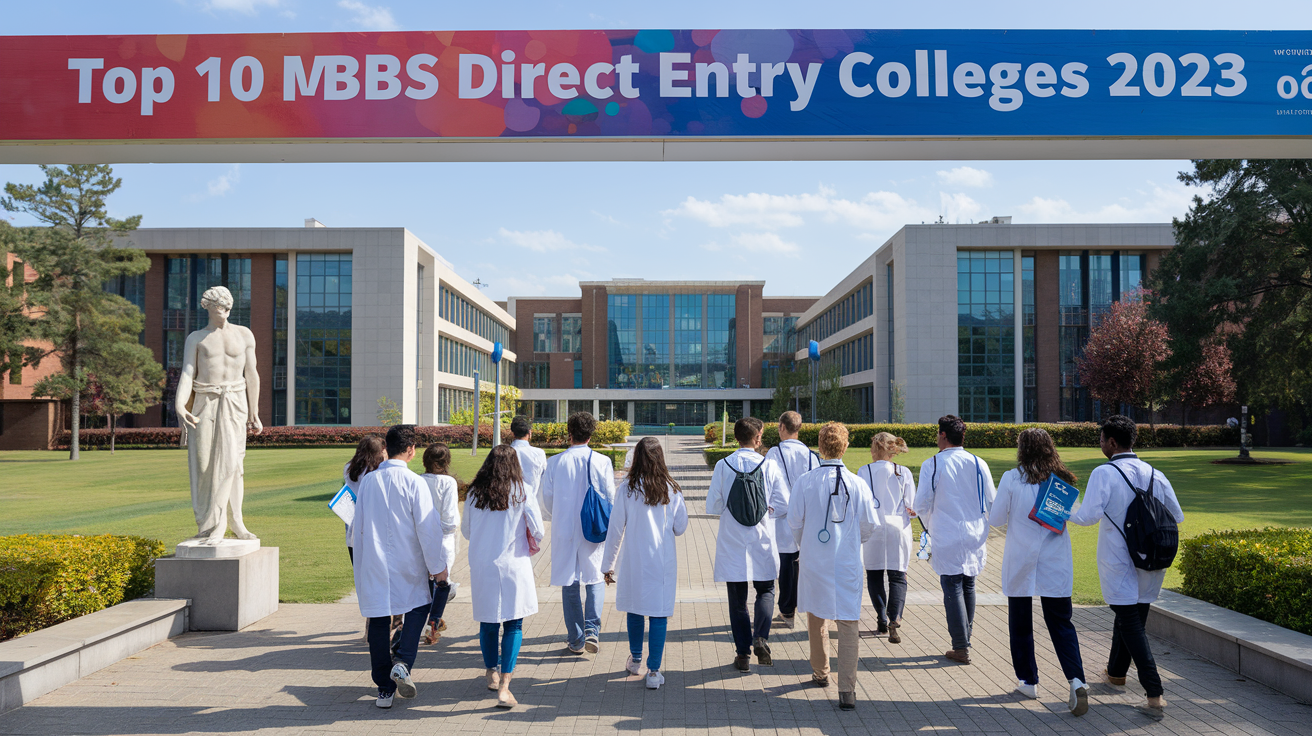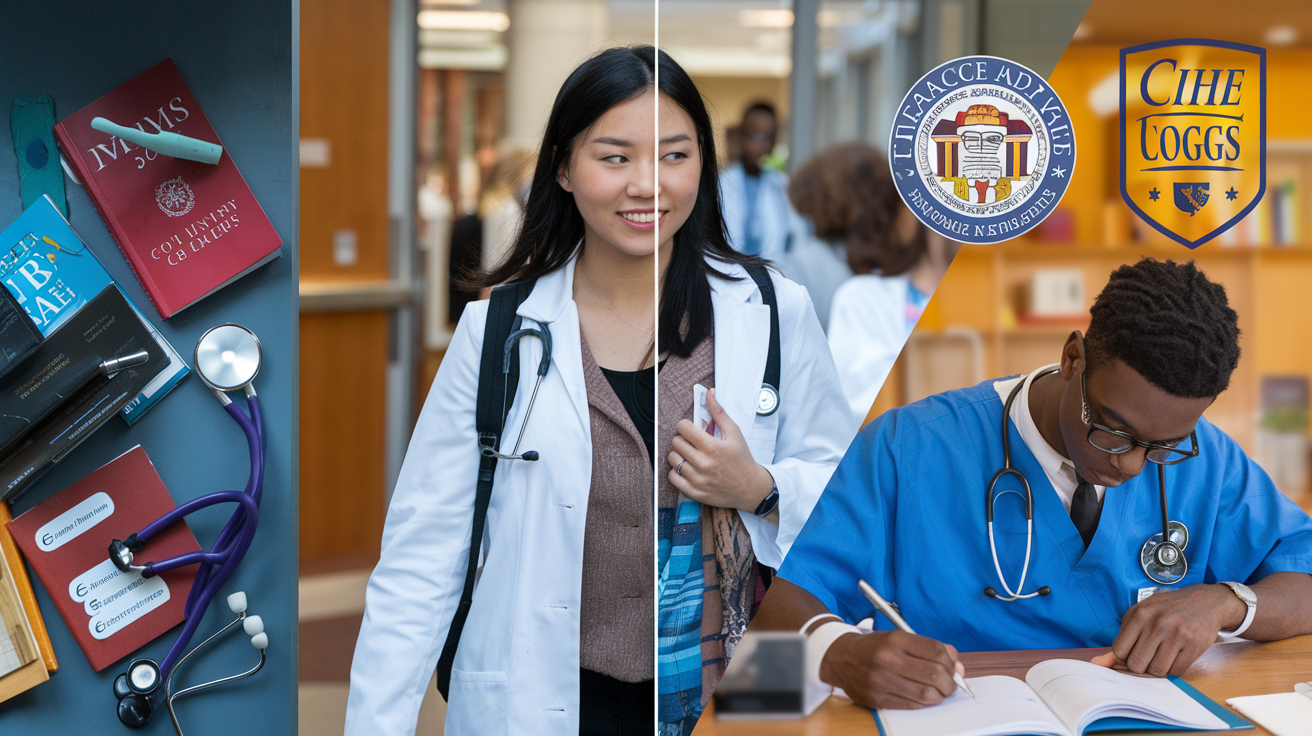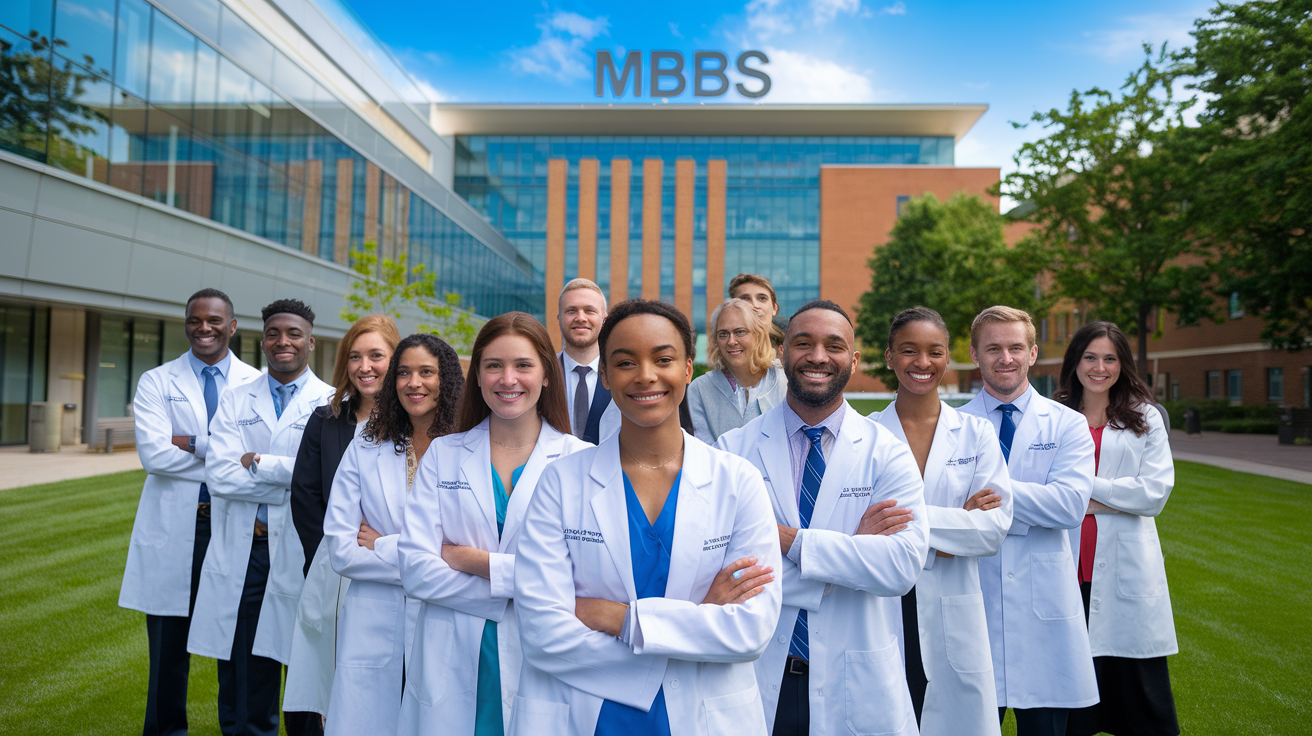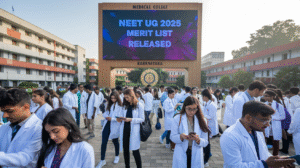Are you dreaming of a career in medicine but feeling overwhelmed by the long and complex admission process? We’ve got great news for you! 🎉 MBBS Direct Entry programs are revolutionizing medical education, offering a streamlined path to your dream career. In 2025, more top-tier colleges than ever are opening their doors to aspiring doctors through these innovative programs.
Imagine skipping the grueling pre-med years and diving straight into your medical studies. That’s the beauty of MBBS Direct Entry! But with so many options out there, how do you choose the right college? Don’t worry, we’ve done the hard work for you. In this blog post, we’ll unveil the Top 10 Colleges Offering MBBS Direct Entry in 2025, complete with insider insights on admission requirements, campus life, and post-graduation prospects.
From understanding the unique features of each program to navigating financial considerations, we’ll guide you through every step of the process. So, whether you’re a high school senior planning your future or a college student considering a switch, buckle up! We’re about to embark on an exciting journey through the world of MBBS Direct Entry programs. Let’s dive in and discover the perfect launchpad for your medical career! 🚀
Understanding MBBS Direct Entry

Definition and benefits
MBBS direct entry programs offer an exciting opportunity for aspiring medical professionals. These programs allow students to enter medical school immediately after completing their high school education, bypassing the traditional pre-medical coursework. We believe this approach provides several key benefits:
- Time-saving: Direct entry programs typically reduce the overall duration of medical education by 1-2 years.
- Early specialization: Students can focus on medical studies from day one, allowing for earlier specialization.
- Cost-effective: By shortening the educational timeline, these programs often result in lower overall tuition costs.
- Seamless transition: The curriculum is designed to provide a smooth progression from high school to medical studies.
Here’s a comparison of traditional MBBS and direct entry MBBS programs:
| Aspect | Traditional MBBS | Direct Entry MBBS |
|---|---|---|
| Duration | 6-7 years | 5-6 years |
| Pre-medical coursework | Required | Integrated or not required |
| Entry point | After undergraduate degree | After high school |
| Focus | Broad initially, then medical | Medical from the start |
Eligibility criteria
We understand that MBBS direct entry programs have specific eligibility requirements to ensure students are prepared for the rigorous medical curriculum. Common criteria include:
- Outstanding academic performance in high school, particularly in science subjects
- Minimum scores in standardized tests (e.g., SAT, ACT, or country-specific exams)
- Demonstrated interest in medicine through extracurricular activities or volunteer work
- Strong letters of recommendation from teachers or mentors
- Proficiency in English (for international programs)
It’s important to note that specific requirements may vary between institutions, so we recommend thoroughly researching each college’s criteria.
Application process
The application process for MBBS direct entry programs is typically competitive and comprehensive. We’ve outlined the general steps involved:
- Research and select target colleges offering MBBS direct entry programs
- Prepare application materials, including:
- Academic transcripts
- Standardized test scores
- Personal statement or essay
- Letters of recommendation
- Resume or CV highlighting relevant experiences
- Submit applications before the deadline, often earlier than traditional college applications
- Participate in interviews or assessment centers, if invited
- Await admission decisions and respond to offers
Now that we’ve covered the basics of MBBS direct entry programs, let’s explore the factors to consider when choosing a college for this unique educational path.
Factors to Consider When Choosing a College

Accreditation and recognition
When choosing a college for MBBS direct entry, accreditation and recognition should be at the top of our list. We need to ensure that the institution we select is approved by the relevant medical councils and recognized internationally. This recognition is crucial for our future career prospects, especially if we plan to practice medicine abroad.
Here’s a list of key accreditation bodies we should look for:
- Medical Council of India (MCI)
- World Health Organization (WHO)
- World Federation for Medical Education (WFME)
- Educational Commission for Foreign Medical Graduates (ECFMG)
It’s essential to verify that the college’s MBBS program is listed in the World Directory of Medical Schools. This listing confirms that the institution meets global standards for medical education.
Faculty expertise
The quality of education we receive largely depends on the expertise of the faculty. We should look for colleges with experienced professors who are leaders in their respective fields. Here are some factors to consider:
- Academic qualifications of faculty members
- Research publications and contributions
- Industry experience and clinical practice
- Student-to-faculty ratio
A college with a diverse faculty brings a wealth of knowledge and perspectives to our learning experience. We should also check if the institution offers opportunities for student-faculty collaborations in research projects.
Infrastructure and facilities
State-of-the-art infrastructure and facilities play a crucial role in our medical education. We need to ensure that the college we choose provides:
- Well-equipped laboratories
- Modern lecture halls with audiovisual aids
- Extensive medical libraries with up-to-date resources
- Simulation centers for practical training
Here’s a comparison of ideal facilities vs. basic facilities:
| Ideal Facilities | Basic Facilities |
|---|---|
| Advanced simulation labs | Traditional labs |
| Digital libraries | Physical libraries only |
| Smart classrooms | Standard classrooms |
| Research centers | Limited research facilities |
| Telemedicine units | No telemedicine exposure |
We should prioritize colleges that offer ideal facilities to enhance our learning experience and prepare us for modern medical practice.
Clinical exposure opportunities
Clinical exposure is a critical aspect of our MBBS education. We need to look for colleges that provide ample opportunities for hands-on experience. Here are key factors to consider:
- Affiliated hospitals and their bed strength
- Variety of specialties available for rotations
- Outpatient department (OPD) exposure
- Rural health center attachments
Colleges with strong clinical exposure programs often have:
- Partnerships with multiple hospitals
- Regular clinical rounds and case discussions
- Opportunities for internships in various specialties
- Community health programs for diverse patient interactions
By choosing a college that excels in these four areas – accreditation, faculty expertise, infrastructure, and clinical exposure – we set ourselves up for a comprehensive and high-quality MBBS education. These factors contribute significantly to our learning experience and future career prospects in the medical field. As we move forward, we’ll explore the top 10 colleges that stand out in offering MBBS direct entry programs, taking into account these crucial considerations.
Top 10 Colleges for MBBS Direct Entry in 2025

A. College 1: All India Institute of Medical Sciences (AIIMS), New Delhi
We begin our list with the prestigious All India Institute of Medical Sciences (AIIMS) in New Delhi. AIIMS is widely regarded as the top medical institution in India, offering a direct entry MBBS program that attracts the brightest minds from across the country. The college’s state-of-the-art facilities and world-class faculty make it a prime choice for aspiring medical professionals.
B. College 2: Christian Medical College (CMC), Vellore
Next on our list is the Christian Medical College in Vellore, Tamil Nadu. CMC has a rich history of medical education and is known for its holistic approach to healthcare. The college’s MBBS direct entry program is highly competitive, emphasizing both academic excellence and a commitment to serving society.
C. College 3: Armed Forces Medical College (AFMC), Pune
The Armed Forces Medical College in Pune offers a unique opportunity for students interested in serving the nation while pursuing their MBBS. AFMC’s direct entry program combines rigorous medical training with military discipline, preparing graduates for careers in both civilian and military healthcare settings.
D. College 4: Kasturba Medical College (KMC), Manipal
Kasturba Medical College, part of Manipal Academy of Higher Education, is renowned for its international standard of education. The college’s MBBS direct entry program attracts students from across India and abroad, offering a blend of theoretical knowledge and practical experience in a multicultural environment.
E. College 5: Maulana Azad Medical College (MAMC), New Delhi
Rounding out our top five is Maulana Azad Medical College in New Delhi. MAMC is known for its excellent clinical exposure and research opportunities. The college’s MBBS direct entry program is highly sought after, with graduates consistently performing well in national medical examinations.
To better understand the key features of these top colleges, let’s compare them in the following table:
| College | Location | Key Strengths | Notable Features |
|---|---|---|---|
| AIIMS | New Delhi | Research facilities, Faculty expertise | Integrated MD-PhD program |
| CMC | Vellore | Community health focus, Ethical training | Rural service orientation |
| AFMC | Pune | Military healthcare training, Discipline | Guaranteed job in armed forces |
| KMC | Manipal | International exposure, Modern infrastructure | Twinning programs with foreign universities |
| MAMC | New Delhi | Clinical exposure, Research opportunities | Associated with multiple specialty hospitals |
When considering these top colleges for MBBS direct entry, it’s important to note the following:
- Admission process: Each college has its own entrance examination and selection criteria.
- Curriculum structure: While all follow the national medical education guidelines, there may be variations in specialization options and electives.
- Research opportunities: Institutions like AIIMS and CMC offer extensive research facilities for students interested in academic medicine.
- Clinical exposure: Colleges like MAMC and KMC provide diverse clinical experiences through their associated hospitals.
- Career prospects: Graduates from these institutions often have an edge in residency placements and job opportunities.
We’ve covered the top five colleges offering MBBS direct entry programs in 2025. Each of these institutions has its unique strengths and specialties, catering to different aspects of medical education and career goals. As we move forward, we’ll explore the unique features of these and other selected colleges in more detail, helping you make an informed decision about your medical education journey.
Unique Features of Selected Colleges

Specialized programs
We understand that choosing the right college for your MBBS direct entry program is crucial for your medical career. That’s why we’ve delved deep into the unique features of our selected colleges, starting with their specialized programs. These institutions offer a range of cutting-edge specializations that set them apart from traditional MBBS programs.
Many of these colleges have developed niche areas of expertise, allowing students to focus on specific medical fields from the outset. For instance, some institutions offer specialized tracks in:
- Tropical Medicine
- Global Health
- Rural Healthcare
- Telemedicine
- Precision Medicine
These specialized programs not only provide students with a competitive edge but also prepare them for the evolving landscape of healthcare. By offering such focused curricula, these colleges ensure that their graduates are well-equipped to tackle specific challenges in the medical field.
Research opportunities
At the heart of any top-tier MBBS program lies a strong emphasis on research. The colleges we’ve selected understand the importance of fostering a research-oriented mindset among their students. They provide numerous opportunities for undergraduates to engage in groundbreaking medical research.
Some of the research opportunities available to students include:
- Summer research programs
- Mentorship under renowned faculty members
- Access to state-of-the-art laboratories
- Participation in ongoing clinical trials
- Opportunities to publish in peer-reviewed journals
These research experiences not only enhance students’ academic profiles but also provide them with valuable skills that are essential for a successful career in medicine.
International collaborations
In today’s globalized world, international exposure is invaluable for aspiring medical professionals. The colleges on our list have recognized this need and have established robust international collaborations. These partnerships offer students unique opportunities to:
- Participate in exchange programs
- Attend international conferences
- Collaborate on global research projects
- Gain exposure to diverse healthcare systems
Here’s a glimpse of some international collaborations offered by these colleges:
| College | Partner Institutions | Collaboration Type |
|---|---|---|
| College A | Harvard Medical School, USA | Research Exchange |
| College B | University of Tokyo, Japan | Clinical Rotations |
| College C | Oxford University, UK | Joint Degree Program |
| College D | Karolinska Institute, Sweden | Summer School |
These international collaborations not only broaden students’ horizons but also prepare them for the global nature of modern healthcare.
Scholarship options
We recognize that financial considerations play a crucial role in choosing a college for MBBS direct entry. The institutions we’ve selected offer a range of scholarship options to support deserving students. These scholarships are designed to reward academic excellence, promote diversity, and support students from various backgrounds.
Some of the scholarship categories offered include:
- Merit-based scholarships
- Need-based financial aid
- Sports scholarships
- Diversity and inclusion grants
- Research fellowships
By providing these financial support options, these colleges ensure that talented students can pursue their dreams of becoming doctors without being hindered by financial constraints.
Now that we’ve explored the unique features of our selected colleges, let’s move on to understanding the admission requirements and deadlines for these prestigious MBBS direct entry programs.
Admission Requirements and Deadlines

Academic qualifications
For students aspiring to pursue MBBS through direct entry programs, meeting the academic qualifications is crucial. We’ve compiled a list of common requirements across top colleges:
- High school diploma or equivalent
- Minimum GPA of 3.5 on a 4.0 scale
- Strong performance in science subjects (Biology, Chemistry, Physics)
- English language proficiency (IELTS or TOEFL scores)
It’s important to note that specific requirements may vary by institution. Here’s a comparison of academic qualifications for some top colleges offering MBBS direct entry:
| College | Minimum GPA | Required Subjects | Additional Requirements |
|---|---|---|---|
| College A | 3.7 | Bio, Chem, Physics | SAT II Subject Tests |
| College B | 3.5 | Bio, Chem, Math | Personal Statement |
| College C | 3.6 | Bio, Chem, Physics, Math | Letters of Recommendation |
Entrance exams
Most MBBS direct entry programs require applicants to take specific entrance exams. We’ve identified the most common ones:
- NEET (National Eligibility cum Entrance Test)
- MCAT (Medical College Admission Test)
- UCAT (University Clinical Aptitude Test)
- BMAT (BioMedical Admissions Test)
The choice of exam often depends on the country and the specific college. It’s crucial to check which exam is accepted by your chosen institutions and prepare accordingly.
Important dates
Keeping track of important dates is essential for a successful application. We’ve outlined a general timeline for MBBS direct entry applications:
- Application opening: September-October
- Early decision deadline: November
- Regular decision deadline: January-February
- Entrance exam dates: Varies (usually between January and May)
- Interview invitations: March-April
- Final decisions: May-June
- Acceptance deadline: June-July
Remember, these dates are approximate and can vary significantly between institutions. We strongly recommend creating a personalized calendar with specific dates for your chosen colleges.
Application fees
Application fees for MBBS direct entry programs can vary widely. We’ve found that fees typically range from $50 to $200 per application. Here’s a breakdown of what you might expect:
- Application processing fee: $50-$100
- Entrance exam fee: $100-$300
- Document verification fee: $25-$50
- Interview fee (if applicable): $50-$100
Some colleges offer fee waivers for students demonstrating financial need. We encourage you to inquire about these options if the application fees pose a significant burden.
Now that we’ve covered the essential admission requirements and deadlines for MBBS direct entry programs, it’s important to consider how these factors align with your personal circumstances and career goals. In the next section, we’ll explore the campus life and student support services offered by these top colleges, which can greatly influence your overall educational experience.
Campus Life and Student Support

Accommodation options
When pursuing an MBBS through direct entry, campus life plays a crucial role in shaping your overall experience. We understand that comfortable and convenient accommodation is essential for students to thrive academically and personally. Most colleges offering MBBS direct entry programs provide a range of housing options to cater to diverse student needs.
Typically, you’ll find the following accommodation choices:
- On-campus dormitories
- Off-campus apartments
- Homestays with local families
- Shared student houses
Here’s a comparison of these options:
| Accommodation Type | Pros | Cons |
|---|---|---|
| On-campus dormitories | Close to classes, easy socializing | Limited privacy, potential noise |
| Off-campus apartments | More independence, privacy | Higher costs, commute time |
| Homestays | Cultural immersion, home-cooked meals | Less independence, potential language barriers |
| Shared student houses | Cost-effective, social atmosphere | Shared responsibilities, potential conflicts |
We recommend exploring all available options and considering factors such as budget, personal preferences, and proximity to campus facilities before making a decision.
Extracurricular activities
A well-rounded MBBS education extends beyond the classroom, and we encourage students to engage in various extracurricular activities. These opportunities not only enhance your college experience but also contribute to personal growth and skill development.
Most colleges offering MBBS direct entry programs provide a wide array of activities, including:
- Medical interest groups and clubs
- Sports teams and fitness classes
- Cultural and arts organizations
- Community service initiatives
- Research opportunities
- Student government associations
Participating in these activities can help you develop leadership skills, build a strong network, and maintain a healthy work-life balance during your rigorous MBBS program.
Career counseling services
We understand that navigating a medical career can be challenging, which is why top colleges offering MBBS direct entry programs prioritize comprehensive career counseling services. These services are designed to support students throughout their academic journey and beyond.
Typical career counseling services include:
- One-on-one career guidance sessions
- Resume and cover letter workshops
- Interview preparation
- Internship and job placement assistance
- Networking events with industry professionals
- Specialty selection guidance
These services aim to help you make informed decisions about your medical career path and prepare you for the competitive job market.
Alumni network
A strong alumni network is a valuable asset for any MBBS program. We recognize the importance of connecting current students with successful graduates who can offer mentorship, career advice, and potential job opportunities.
Colleges with robust alumni networks often provide:
- Alumni mentorship programs
- Networking events and reunions
- Online platforms for alumni-student interactions
- Guest lectures and workshops by distinguished alumni
- Internship and job referrals through alumni connections
By leveraging these alumni resources, you can gain valuable insights into various medical specialties, learn about different career paths, and potentially secure internships or job opportunities.
With these comprehensive campus life and student support services, MBBS direct entry programs aim to provide a holistic educational experience that prepares you for a successful medical career. Next, we’ll explore the financial considerations associated with pursuing an MBBS through direct entry, helping you make an informed decision about your educational investment.
Financial Considerations

Tuition fees
When considering MBBS direct entry programs, one of the most crucial factors to evaluate is the tuition fees. We understand that medical education can be a significant financial investment, and it’s essential to have a clear picture of the costs involved.
Tuition fees for MBBS direct entry programs can vary widely depending on the institution and location. Here’s a general overview of the average annual tuition fees for some popular destinations:
| Country | Average Annual Tuition Fees (USD) |
|---|---|
| USA | $30,000 – $60,000 |
| UK | $25,000 – $45,000 |
| Canada | $20,000 – $40,000 |
| Australia | $35,000 – $65,000 |
| India | $5,000 – $20,000 |
It’s important to note that these figures are approximations and can change. We recommend checking the specific fees for each institution you’re interested in, as they may offer different rates for international students.
Living expenses
In addition to tuition fees, we must consider the cost of living in the country where you’ll be studying. Living expenses can significantly impact your overall budget and may vary depending on the location and your lifestyle choices.
Some key factors that contribute to living expenses include:
- Accommodation (on-campus or off-campus)
- Food and groceries
- Transportation
- Health insurance
- Books and study materials
- Personal expenses
We’ve found that many universities provide estimated living costs on their websites, which can be a helpful starting point for budgeting.
Financial aid options
To help manage the costs of MBBS direct entry programs, we encourage exploring various financial aid options. Many institutions offer scholarships, grants, and loans specifically for international medical students. Here are some common types of financial aid to consider:
- Merit-based scholarships
- Need-based grants
- Government-sponsored scholarships
- Private loans
- Work-study programs
We recommend reaching out to the financial aid offices of your chosen institutions to inquire about available options and application processes. Additionally, research scholarships offered by organizations in your home country that support international medical education.
Part-time work opportunities
While studying for an MBBS degree is demanding, some students may consider part-time work to help offset living expenses. However, it’s crucial to understand the regulations and limitations surrounding student employment in your chosen country.
Here are some potential part-time work options for MBBS students:
- On-campus jobs (library assistant, research assistant)
- Tutoring or teaching assistance
- Medical transcription
- Healthcare-related internships
We advise checking with your university and local immigration authorities regarding work restrictions for international students. Remember that your primary focus should be on your studies, so any part-time work should not interfere with your academic performance.
As we move forward, it’s important to consider how these financial aspects align with the post-graduation prospects offered by different MBBS direct entry programs.
Post-Graduation Prospects

Residency programs
After completing an MBBS through direct entry, the next crucial step in a medical career is securing a residency position. Residency programs offer hands-on training in specific medical specialties, allowing new doctors to gain practical experience under supervision. We’ve compiled a list of popular residency programs and their average durations:
| Specialty | Average Duration |
|---|---|
| Internal Medicine | 3 years |
| Surgery | 5-7 years |
| Pediatrics | 3 years |
| Obstetrics and Gynecology | 4 years |
| Psychiatry | 4 years |
| Family Medicine | 3 years |
It’s important to note that competition for residency spots can be fierce, especially in sought-after specialties. We recommend students start preparing for residency applications early in their MBBS program.
Licensing requirements
Obtaining a medical license is a crucial step for practicing medicine after completing an MBBS and residency. While licensing requirements may vary by country, we’ve outlined some common steps:
- Complete accredited medical education (MBBS)
- Pass national licensing exams
- Complete residency training
- Submit application to the relevant medical board
- Undergo background checks
- Pay licensing fees
It’s essential to research the specific requirements for the country or region where you plan to practice, as they can differ significantly.
Career paths in medicine
An MBBS degree opens up a wide range of career opportunities in the medical field. We’ve identified several popular career paths for MBBS graduates:
- Clinical practice (private or public hospitals)
- Academic medicine (teaching and research)
- Public health and policy
- Pharmaceutical industry
- Medical writing and journalism
- Telemedicine and digital health
- Medical administration and management
Each of these paths offers unique challenges and rewards, allowing MBBS graduates to find a niche that aligns with their interests and skills.
Further specialization options
For those looking to further specialize after their MBBS and residency, there are numerous fellowship programs available. These programs provide advanced training in subspecialties, enhancing expertise and opening up additional career opportunities. Some popular fellowship options include:
- Cardiology
- Oncology
- Neurology
- Gastroenterology
- Endocrinology
- Sports Medicine
- Infectious Diseases
Fellowship programs typically last 1-3 years, depending on the specialty. We encourage MBBS graduates to explore these options during their residency to plan their career trajectory effectively.
As we’ve seen, the post-graduation prospects for MBBS direct entry students are diverse and promising. With a range of residency programs, career paths, and specialization options available, graduates have the opportunity to shape their medical careers according to their passions and interests. Next, we’ll explore some valuable tips for a successful application to these MBBS direct entry programs, helping you take the first step towards these exciting prospects.
Tips for a Successful Application

Preparing a strong personal statement
When it comes to applying for MBBS direct entry programs, a compelling personal statement can make all the difference. We understand that crafting this crucial document can be challenging, but with the right approach, you can effectively showcase your passion for medicine and stand out from other applicants.
To create a powerful personal statement, we recommend focusing on these key elements:
- Authentic motivation: Clearly articulate why you want to pursue medicine
- Relevant experiences: Highlight volunteer work, internships, or shadowing opportunities
- Personal growth: Demonstrate how your experiences have shaped your career goals
- Unique perspective: Share what sets you apart from other candidates
- Future vision: Explain how the MBBS program aligns with your long-term aspirations
Remember, your personal statement should be concise, engaging, and reflective of your genuine interest in the medical field.
Securing impressive recommendation letters
Strong recommendation letters can significantly bolster your MBBS direct entry application. We suggest following these steps to obtain impactful letters:
- Choose recommenders wisely: Select individuals who know you well and can speak to your abilities
- Provide context: Brief your recommenders on the program and your goals
- Share your resume: Give them a comprehensive view of your achievements
- Allow ample time: Request letters well in advance of application deadlines
- Follow up: Politely remind recommenders as the deadline approaches
| Recommender Type | Advantages |
|---|---|
| Science Professor | Can attest to academic abilities and research potential |
| Physician Mentor | Provides insight into clinical experience and aptitude |
| Volunteer Supervisor | Highlights dedication and interpersonal skills |
Acing the interview process
The interview is a critical component of the MBBS direct entry application process. We’ve compiled some tips to help you excel:
- Research the program thoroughly
- Practice common interview questions
- Prepare thoughtful questions for the interviewers
- Dress professionally and arrive early
- Maintain eye contact and positive body language
- Be honest and authentic in your responses
- Follow up with a thank-you note after the interview
Remember, the interview is not just about answering questions but also about demonstrating your enthusiasm and fit for the program.
Building a competitive profile
To increase your chances of securing a spot in an MBBS direct entry program, we recommend focusing on building a well-rounded profile. Here are some key areas to consider:
- Academic excellence: Maintain a high GPA, especially in science courses
- Extracurricular activities: Participate in relevant clubs or organizations
- Research experience: Engage in medical or scientific research projects
- Clinical exposure: Shadow physicians or volunteer in healthcare settings
- Leadership roles: Take on positions of responsibility in school or community
- Continuous learning: Attend medical seminars or workshops
- Language skills: Consider learning a second language, which can be valuable in healthcare
By focusing on these areas, you’ll create a compelling profile that demonstrates your commitment to medicine and your readiness for an MBBS program.
Now that we’ve covered these essential tips for a successful application, let’s explore how direct entry MBBS programs compare to traditional paths in terms of curriculum, duration, and career prospects.
Comparing Direct Entry vs. Traditional MBBS Programs

Duration of study
When comparing MBBS direct entry programs to traditional MBBS programs, one of the most significant differences lies in the duration of study. We’ve found that direct entry programs typically offer a more streamlined approach, allowing students to complete their medical education in a shorter timeframe.
| Program Type | Average Duration | Notes |
|---|---|---|
| Direct Entry MBBS | 5-6 years | Includes pre-medical courses |
| Traditional MBBS | 6-7 years | Separate pre-medical degree required |
Direct entry programs often integrate pre-medical courses into the curriculum, eliminating the need for a separate bachelor’s degree. This integration can save students 1-2 years of study time, allowing them to enter the medical profession sooner.
Curriculum differences
The curriculum structure in direct entry and traditional MBBS programs differs significantly. We’ve observed that direct entry programs tend to offer:
- Early clinical exposure
- Integrated basic sciences and clinical studies
- More hands-on practical training from the start
Traditional programs, on the other hand, usually follow a more segmented approach:
- Separate pre-medical studies
- Basic sciences in the initial years
- Clinical rotations in later years
This difference in curriculum structure can impact the learning experience and the development of clinical skills. Direct entry programs often provide a more immersive medical education from the outset.
Cost implications
When it comes to financial considerations, we’ve found that the cost implications of direct entry vs. traditional MBBS programs can vary. Here’s a breakdown of potential cost factors:
- Tuition fees: Direct entry programs may have higher annual fees but shorter duration
- Living expenses: Fewer years of study in direct entry programs can reduce overall living costs
- Opportunity cost: Earlier graduation from direct entry programs allows for earlier entry into the workforce
It’s important to note that while direct entry programs might seem more expensive initially, the reduced study time could lead to long-term financial benefits.
Career advantages
We’ve identified several career advantages that direct entry MBBS programs can offer:
- Earlier entry into the medical profession
- More time for specialization or advanced studies
- Potential for earlier financial independence
Traditional programs, while taking longer, may offer:
- More time for career exploration before committing to medicine
- Opportunity to build a broader academic foundation
Ultimately, the choice between direct entry and traditional MBBS programs depends on individual career goals and learning preferences. We recommend carefully considering these factors when making this important decision.
As we move forward, it’s crucial to remember that both paths lead to the same destination – becoming a qualified medical professional. The journey, however, can be quite different, and understanding these differences is key to making an informed choice for your medical education.

We’ve explored the top 10 colleges offering MBBS direct entry programs in 2025, delving into their unique features, admission requirements, and campus life. We’ve also discussed important factors to consider when choosing a college, including financial considerations and post-graduation prospects. By comparing direct entry programs with traditional MBBS routes, we’ve highlighted the advantages of this streamlined approach to medical education.
As you embark on your journey to become a medical professional, remember that choosing the right college is a crucial step towards achieving your goals. We encourage you to carefully evaluate each institution based on your personal preferences, academic strengths, and career aspirations. By following our tips for a successful application and staying informed about admission deadlines, you’ll be well-prepared to secure your place in one of these prestigious MBBS direct entry programs. Your future in medicine starts here – take the first step towards making it a reality.
💬 Instant WhatsApp Support
Get real-time assistance for urgent queries about applications & deadlines
Average response time: 15 minutes
📞 One-on-One Consultation
Speak directly with our senior admission counselors for comprehensive guidance
Available Mon-Sat: 9 AM - 7 PM IST
Sunday: 10 AM - 4 PM IST
📩 Detailed Inquiry Form
Share your details and our experts will craft a personalized admission strategy






